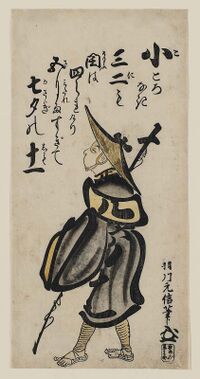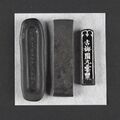Difference between revisions of "Category:Carbon black:Ukiyo-e colorant"
| (11 intermediate revisions by the same user not shown) | |||
| Line 1: | Line 1: | ||
| − | [[File:SC204073.jpg|right| | + | [[File:SC204073.jpg|right|200px|link=Chinchō, Saigyo Hôshi on a Pilgrimage; Calendar for 1724, 11.13261| Saigyo Hôshi on a Pilgrimage by Hanekawa Chinchō]] |
| − | <font size="3">'''[[Carbon black]]'''</font> 墨(''sumi''): A fine particle carbon pigment obtained as soot from the incomplete combustion of many different types of organic materials | + | <font size="3">'''[[Carbon black]]'''</font> 墨 (''sumi''): A fine particle carbon pigment obtained as soot from the incomplete combustion of many different types of organic materials. In Japan, the two main types of carbon black are [[Lampblack|lamp black]] and [[Pine-soot black|pine soot black]]. The soot is mixed with animal glue (膠 ''nikawa'') to produce ink sticks. Lamp black (油煙墨 ''yuen boku'') is made from burning [[Rapeseed oil|rapeseed oil]] or [[Sesame oil|sesame oil]] as well as other oils. Pine soot black (松煙墨 ''shōen boku'') is made by burning pinewood. While the color can range from a brownish to bluish black, lamp blacks are usually dark black and pine soot blacks are bluish black. |
| − | Carbon black can be printed to produce a range of gray to blacks. It can also be added to other colorants to darken the color. On early hand-colored prints called | + | Carbon black can be printed to produce a range of gray to blacks. It can also be added to other colorants to darken the color. On early hand-colored prints called ''urushi-e'' (漆絵), animal glue was added to carbon black, which gave it a sheen like lacquer, or ''urushi''. The lines of the key-block and printed black areas are most likely lamp black. Black areas are sometimes manipulated by embossing or burnishing to create patterns within the area and/or to create a sheen, and is frequently used to depict lacquerware. Bluish gray areas which do not produce an analytical result of blue, may be an indication of pine soot black either used alone or mixed with one of the whites. |
| − | '''For additional information see:''' [[Carbon black]], [[Lampblack]], [[Pine-soot black|Pine soot black]] | + | '''For additional information see:''' [[Carbon black]], [[Lampblack|Lamp black]], [[Pine-soot black|Pine soot black]] |
<br> | <br> | ||
| − | + | <br> | |
| + | <!-- | ||
== Examples of Carbon black in Ukiyo-e Prints == | == Examples of Carbon black in Ukiyo-e Prints == | ||
| Line 40: | Line 41: | ||
| | | | ||
[[File:Indigo FORS.JPG|200px]]<br>[[Harunobu, Beautiful Women of the Yoshiwara, Applying makeup (MFA 2006.1537.5)|Beauties of the Yoshiwara by Suzuki Harunobu]] | [[File:Indigo FORS.JPG|200px]]<br>[[Harunobu, Beautiful Women of the Yoshiwara, Applying makeup (MFA 2006.1537.5)|Beauties of the Yoshiwara by Suzuki Harunobu]] | ||
| − | |} | + | |}--> |
| − | |||
== Analysis == | == Analysis == | ||
| − | + | [[Raman spectroscopy]] can be used to identify carbon black but black as a single colorant or in a mixture was not analyzed in this research. | |
| + | |||
==Images of Carbon black == | ==Images of Carbon black == | ||
<gallery> | <gallery> | ||
| − | 505 lampblack.jpg| | + | 505 lampblack.jpg|Lamp black |
| − | lampblack C100x.jpg| | + | lampblack C100x.jpg|Lamp black at 100x |
File:Inksticks.jpg|Ink sticks | File:Inksticks.jpg|Ink sticks | ||
Sk6HjPHjo7k-SD.jpg|Nara Sumi (Inksticks) (video), <small>by Japan traditional crafts Aoyama Square</small>|link=https://www.youtube.com/watch?v=sk6HjPHjo7k | Sk6HjPHjo7k-SD.jpg|Nara Sumi (Inksticks) (video), <small>by Japan traditional crafts Aoyama Square</small>|link=https://www.youtube.com/watch?v=sk6HjPHjo7k | ||
| − | DqTaCPwWfKM-SD.jpg|Making pine soot | + | DqTaCPwWfKM-SD.jpg|Making pine soot (video), <small>by kishushoen</small>|link=https://www.youtube.com/watch?v=DqTaCPwWfKM |
20462545.jpg|Carbon black (audio), <small>by Harvard Art Museums</small>|link=https://harvardartmuseums.org/tour/660/slide/11162 | 20462545.jpg|Carbon black (audio), <small>by Harvard Art Museums</small>|link=https://harvardartmuseums.org/tour/660/slide/11162 | ||
</gallery> | </gallery> | ||
Latest revision as of 03:10, 15 April 2024
Carbon black 墨 (sumi): A fine particle carbon pigment obtained as soot from the incomplete combustion of many different types of organic materials. In Japan, the two main types of carbon black are lamp black and pine soot black. The soot is mixed with animal glue (膠 nikawa) to produce ink sticks. Lamp black (油煙墨 yuen boku) is made from burning Rapeseed oil or Sesame oil as well as other oils. Pine soot black (松煙墨 shōen boku) is made by burning pinewood. While the color can range from a brownish to bluish black, lamp blacks are usually dark black and pine soot blacks are bluish black.
Carbon black can be printed to produce a range of gray to blacks. It can also be added to other colorants to darken the color. On early hand-colored prints called urushi-e (漆絵), animal glue was added to carbon black, which gave it a sheen like lacquer, or urushi. The lines of the key-block and printed black areas are most likely lamp black. Black areas are sometimes manipulated by embossing or burnishing to create patterns within the area and/or to create a sheen, and is frequently used to depict lacquerware. Bluish gray areas which do not produce an analytical result of blue, may be an indication of pine soot black either used alone or mixed with one of the whites.
For additional information see: Carbon black, Lamp black, Pine soot black
Analysis
Raman spectroscopy can be used to identify carbon black but black as a single colorant or in a mixture was not analyzed in this research.
Images of Carbon black
This category currently contains no pages or media.






